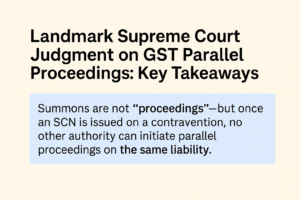INTRODUCTION
The Central Goods and Services Tax (CGST) Act, 2017, vests authorities with significant enforcement powers, including the power to arrest individuals in cases of tax evasion or other serious violations. Recognizing the importance of safeguarding personal liberty while ensuring compliance with tax laws, the Central Board of Indirect Taxes and Customs (CBIC) periodically issues detailed guidelines to standardize the exercise of these powers.
Instruction No. 02/2022-23, dated August 17, 2022, established comprehensive procedural frameworks and principles to govern arrests under the CGST Act. These guidelines emphasized judicial safeguards, transparency, and proportionality in enforcement actions. Subsequently, in response to judicial pronouncements, Instruction No. 01/2025, dated January 13, 2025, was issued to refine these protocols further. This amendment clarified critical distinctions between the “reasons for arrest” and the “grounds of arrest,” incorporating the need for written communication to the accused.
This article will provides an in-depth analysis of the instructions, highlights the procedural reforms, and examines the judicial precedents that have shaped these developments, underscoring the commitment to balance effective tax enforcement with respect for individual rights.
Key Points from Instruction No. 02/2022-23
This instruction (dated August 17, 2022) provides a framework for arrests under the CGST Act, emphasizing the protection of individual liberty and ensuring that arrests are not made arbitrarily. The instructions includes:
1.. Conditions Precedent to Arrest:
- Arrests should be based on credible material and must fulfill the legal prerequisites of Section 132 of the CGST Act, 2017.
- Arrests should not be mechanical or routine, and the “reasons to believe” must be unambiguous.
2. Factors to Consider Before Arrest:
- Evidence of tax evasion or fraudulent activities.
- The necessity of arrest for proper investigation, tampering prevention, or ensuring the accused’s presence.
- Cooperation of the accused in the investigation.
- Avoiding arrests in cases of technical interpretation disputes.
3. Procedure for Arrest:
- Approval by the Commissioner with due documentation.
- Compliance with the Supreme Court’s guidelines on arrest and custodial procedures.
- A detailed arrest memo explaining the grounds for arrest.
- Specific provisions for the arrest of women and medical examinations post-arrest.
4. Post-Arrest Formalities:
- Immediate release on bail if eligible.
- Filing a prosecution complaint within a stipulated period, preferably 60 days.
4. Reporting Requirements:
- Detailed reporting of arrests to the CBIC and maintaining monthly records.
Recent Amendments in Instruction No. 01/2025
This amendment (dated January 13, 2025) modifies the guidelines in light of judicial rulings, particularly addressing procedural clarity and communication regarding arrests.
- Grounds vs. Reasons for Arrest:
- Following rulings from the Hon’ble Supreme Court and Delhi High Court, the amendment distinguishes between “reasons for arrest” (general) and “grounds of arrest” (specific to the individual accused).
- The “grounds of arrest” must be detailed, communicated in writing, and attached to the arrest memo.
2. Revised Arrest Memo Requirements:
- Para 4.2.1 was updated to mandate the written communication of the grounds of arrest to the accused as an annexure to the arrest memo.
- Acknowledgment of receipt must be obtained from the accused.
Summary of the Changes
- 2022 Instruction: Focused on establishing broad principles and procedures for arrests under GST with a primary focus on balancing enforcement and individual liberty.
- 2025 Amendment: Introduced specificity in procedural aspects, particularly emphasizing the accused’s right to be informed of the grounds for arrest, in response to recent judicial clarifications.
These changes aim to enhance procedural transparency, align with judicial expectations, and ensure fair treatment during GST-related enforcement actions.



Add comment